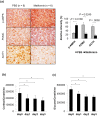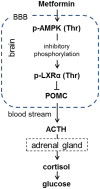Antihyperglycemic mechanism of metformin occurs via the AMPK/LXRα/POMC pathway
- PMID: 25634597
- PMCID: PMC4311245
- DOI: 10.1038/srep08145
Antihyperglycemic mechanism of metformin occurs via the AMPK/LXRα/POMC pathway
Abstract
Metformin is a first-line drug for treating type 2 diabetes. Although metformin is known to phosphorylate AMP-activated protein kinase (AMPK), it is unclear how the glucose-lowering effect of metformin is related to AMPK activation. The aim of this study was to identify the urinary endogenous metabolites affected by metformin and to identify the novel underlying molecular mechanisms related to its anti-diabetic effect. Fourteen healthy male subjects were orally administered metformin (1000 mg) once. First morning urine samples were taken before and after administration to obtain metabolomic data. We then further investigated the anti-diabetic mechanism of metformin in vitro and in vivo. The fluctuation of the metabolite cortisol indicated that the neuroendocrine system was involved in the anti-diabetic effect of metformin. Actually we found that metformin induced AMPK/liver X receptor α (LXRα) phosphorylation, followed by pro-opiomelanocortin (POMC) suppression in rat pituitary cells. We confirmed this result by administering metformin in an animal study. Given that cortisol stimulates gluconeogenesis, we propose the anti-hyperglycemic effect of metformin is attributed to reduced POMC/adrenocorticotropic hormone (ACTH)/cortisol levels following AMPK/LXRα phosphorylation in the pituitaries.
Figures





References
-
- Group, U. P. D. S. U. Effect of intensive blood-glucose control with metformin on complications in overweight patients with type 2 diabetes (UKPDS 34). Lancet 352, 854–865 (1998). - PubMed
-
- Abbasi F. et al. Effect of metformin treatment on multiple cardiovascular disease risk factors in patients with type 2 diabetes mellitus. Metabolism 53, 159–164 (2004). - PubMed
-
- Phung O. J., Scholle J. M., Talwar M. & Coleman C. I. Effect of noninsulin antidiabetic drugs added to metformin therapy on glycemic control, weight gain, and hypoglycemia in type 2 diabetes. JAMA 303, 1410–1418 (2010). - PubMed
-
- Tahrani A. A., Bailey C. J., Del Prato S. & Barnett A. H. Management of type 2 diabetes: new and future developments in treatment. Lancet 378, 182–197 (2011). - PubMed
Publication types
MeSH terms
Substances
LinkOut - more resources
Full Text Sources
Other Literature Sources
Medical
Miscellaneous

